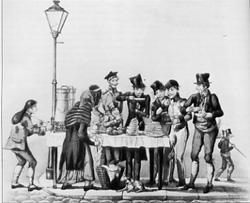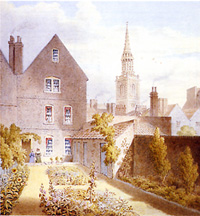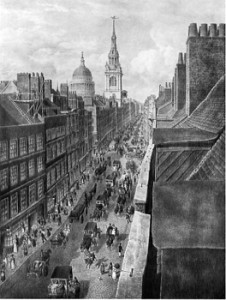 Today, I’m turning to my library again. I’ve pulled out Life in the Georgian City by Dan Cruickshank and Neil Burton. This is a wonderfully detailed book, covering city streets and their buildings, including construction and maintenance, people and services. Naturally, it doesn’t have everything you would need to know. But it’s a darned good place to start. It also has tons of great illustrations.
Today, I’m turning to my library again. I’ve pulled out Life in the Georgian City by Dan Cruickshank and Neil Burton. This is a wonderfully detailed book, covering city streets and their buildings, including construction and maintenance, people and services. Naturally, it doesn’t have everything you would need to know. But it’s a darned good place to start. It also has tons of great illustrations.
As an example, Chapter One starts out with “The Image of the City,” invoking how the architecture (particularly the newly constructed and prolifically built terrace house) “not only determined the way in which life was organized inside the home but also had a profound influence on the way the city was perceived.” The book quotes Louis Simond, the American who visited London in 1810, as typical of the way visitors saw the smoky Georgian city. Another visitor called the city “an enormous murky lump of brick.”
The book then goes on to discuss the coal fires that gave the city its murky quality, followed by a discussion of street paving, cleansing and lighting.
 But the book does not focus solely on the city’s architecture and streets, it also takes a look at the lives of the people who lived there. There’s a wonderful illustration of workmen, procuring breakfast from a street vendor. Something that is so like something we would see today in almost any largish city. Discussion includes daily life, work, entertainment, meals, street hazards, transportation, before moving on to the town houses themselves.
But the book does not focus solely on the city’s architecture and streets, it also takes a look at the lives of the people who lived there. There’s a wonderful illustration of workmen, procuring breakfast from a street vendor. Something that is so like something we would see today in almost any largish city. Discussion includes daily life, work, entertainment, meals, street hazards, transportation, before moving on to the town houses themselves.
The “Common House” chapter of the book includes floor plans and descriptions of each floor in a typical London town house as well as the services needed to keep in running. including fuel, water supply, and drainage. There is a chapter on Construction and Speculation, detailed descriptions and pictures of details of the house, including dados, architraves, skirtings, mouldings, and paint colors.
 In 1700 few small town houses had anything but paved yards. The fourth chapter covers the growth of town gardens with probably less attention to detail than that given to the city and houses. This is likely because there was not as much written on the subject during the period. We have section of Richard Horwood’s map showing the large number of London town gardens in the late 18th century, apparently given early manifestation on the Grosvenor Estate in Maryfair, behind the fashionable houses that were built in the 1720s and 1730s, intended for the more well-to-do who would also have a country estate. There is also discussion of poorer, upper floor residents trying some container gardening with pots on their windowsills.
In 1700 few small town houses had anything but paved yards. The fourth chapter covers the growth of town gardens with probably less attention to detail than that given to the city and houses. This is likely because there was not as much written on the subject during the period. We have section of Richard Horwood’s map showing the large number of London town gardens in the late 18th century, apparently given early manifestation on the Grosvenor Estate in Maryfair, behind the fashionable houses that were built in the 1720s and 1730s, intended for the more well-to-do who would also have a country estate. There is also discussion of poorer, upper floor residents trying some container gardening with pots on their windowsills.
The book concludes with appendixes that include case studies of four locations.
Are you looking for a telling detail to lend authenticity to your city setting? This is the book for you.


Ooh! I need this book. It’s just what I’m looking for. Thanks for the rec!
I love this book!!! I try not to pull it off the shelf unless I need it for a specific detail, or I get lost in it for hours
I know I’ve heard of this, but I don’t have it. You are bad for my research budget, Myretta! 🙂
This is a marvelous book, but do take Amanda’s warning seriously. This book will suck you in and refuse to let you go for hours!